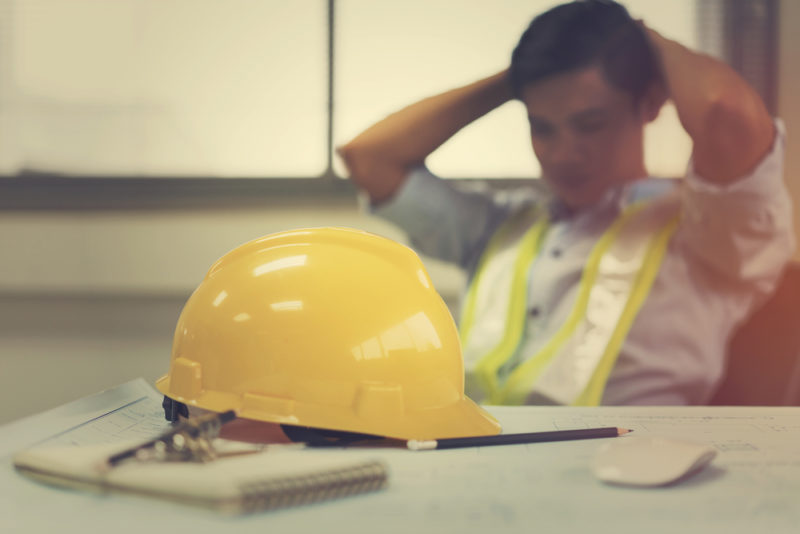In July, I came back from vacation to deal with a settlement in a very large case that had fallen apart. That lead to trips to San Francisco, numerous conference calls with mediators, calls with the client and carriers, and a lot of arguing about the settlement offer that was eventually put back together, after falling apart a second time.
On the second Friday, I was not only angry and physically tired, I was mentally exhausted. I needed to go home and sleep. Fortunately, I ride the train back and forth to downtown Los Angeles, so I didn’t have to drive for 90 minutes in heavy traffic and put my life and possibly yours in danger with the chance I’d fall asleep at the wheel.
When I was rested, I started to wonder about employees who do construction work when they are as exhausted as I was. Do they run heavy equipment or operate dangerous tools on a jobsite in that condition? What is the impact of fatigue in the construction industry? Here’s some of what I found from my research – it’s startling, at least to me.
Fatigue is far more serious than my frequent desire to take a nap in the middle of the afternoon. Being tired can be a symptom of fatigue but being tired is not the same thing. Fatigue is a state of mental or physical exhaustion that prevents a person from functioning normally.
Fatigue is usually caused by lack of an adequate amount of good quality sleep over an extended period. But, it can also be caused by a myriad of other things, such as extended work hours, spending long periods of time awake, working at night, shift changes, repetitive work, work that requires a high level of concentration, working in high heat or extreme cold, long commutes to work, too much overtime, as well as an employee’s personal lifestyle that may include the use of prescription medications, drugs, and/or alcohol.
Much to my surprise, according to Workplace Health and Safety Queensland, being awake for 17 hours is the equivalent of having a blood alcohol level of 0.05 and being awake for an additional three hours is the equivalent of a 0.1 blood alcohol level.
And the National Safety Council reports that losing just two hours of sleep can make a driver as impaired as drinking three beers.
The National Safety Council also reports that 30 percent of drivers reported dozing off when they were behind the wheel. Driving on only four or five hours of sleep means the driver is four times more likely to crash than other drivers.
Each year, 6,400 people die from drowsy-driving crashes. And rolling down your windows, turning on the air conditioning, and playing the radio loudly (what I typically do after a long day in trial) doesn’t prevent us from being drowsy drivers.
According to a National Sleep Foundation poll, 60 percent of adults have driven while they were tired and another 37 percent, or 103 million people, have fallen asleep at the wheel. Of those, 13 percent say they fall asleep while driving at least once a month, and 4 percent say they have caused a crash by falling asleep while driving.
The National Highway Traffic Safety Administration (NHTSA) reports that 100,000 police-reported crashes are a result of driver fatigue. Clearly, most of us don’t recognize the risks that are inherent with fatigue.
“Fatigue diminishes the ability of an individual to perceive risk, and therefore, subconsciously this individual assumes higher risk than he/she normally would under a non-fatigued condition. Fatigue impacts mood and, a negative mood or emotional state has been shown to decrease complex cognitive performance, clouding risk perception.” (Tixier et al. 2014)
In October 2018, the National Safety Council issued the report “Fatigue in Safety-Critical Industries: Impact, Risks and Recommendations” stating that 69 percent of workers across construction, manufacturing, transportation, and utility industries are tired at work, which causes an increased risk of injuries and incidents on the job.
Fatigue impacts the ability to think clearly, decreases attention, and slows reaction time. The report also indicates that up to 13 percent of workplace injuries could be tied to fatigue. Further, workers’ lack of sleep costs $410 billion annually in “societal expenses” related to accidents and reduced productivity, among other things.
And, I would bet that the impact on businesses due to the annual change from standard time to daylight savings time is far more significant than we realize. I can’t be the only one who takes an entire week to adjust to a one-hour time change.
What is noteworthy is that 93 percent of all employers believe that fatigue is a safety issue, but only 72 percent of employees agree, leading to the conclusion that employees are not qualified to determine their own levels of fatigue or the inherent danger of working in a fatigued state.Therefore, supervisors must be vigilant observers of worker fitness.
According to Trekker Group, these are some of the most common signs of fatigue: repeated yawning, nodding off at work, inability to concentrate, loss of strength or stamina, slowing reflexes or reaction times, declining productivity, difficulty communicating, poor judgment or decision-making, needing frequent breaks, experiencing headaches or feeling lightheaded, and blurry vision. Both supervisors and workers need to be trained on the signs and dangers of fatigue, and the measures that can be taken to prevent it.
Most of us blow off fatigue as no big deal. Our culture is founded upon and admires hard work and putting in the hours. However, based on the inherent risks in working dangerous construction jobs in a fatigued state, we all need to reconnect with what fatigue is and how it can adversely impact our lives.


